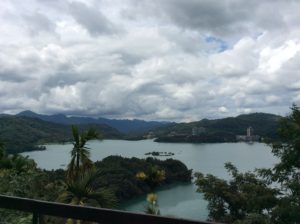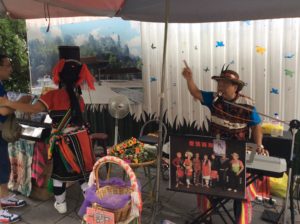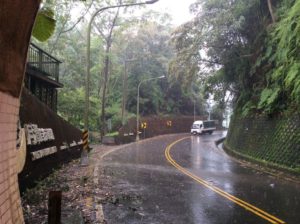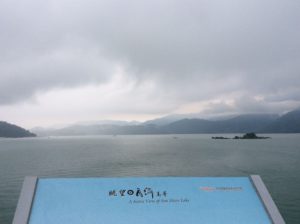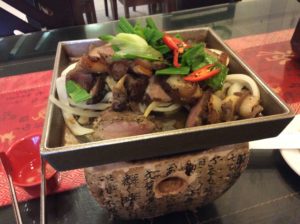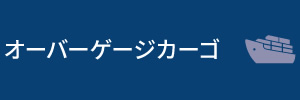HOME > ジャパトラブログ&ニュース
2020年02月26日
コラム/最適物流の科学㊻
最適物流の科学
弊社社長の菅が、2017年12月に『最適物流の科学―舞台は3億6106万平方km。
海を駆け巡る「眠らない仕事」』という書籍を出版しました。
そこで、本ブログでも、その書籍から抜粋した内容を
毎週1話ずつ、ご紹介していきたいと思います。
第四十六回となる今回は、「海運業界は時代の大海原をどのように航海すべきか~国の生命線を守れ!」というテーマで「合理化策としての大型化がもたらす影響」をお話しいたします。
↓
↓
——————————————————————————————————–
「合理化策としての大型化がもたらす影響」
コンテナ船が大型化すれば、一度に運べる貨物の量は増加します。同時に、船舶の合理化により輸送に必要な燃料費や人件費などの削減が図れ、一コンテナ当たりの輸送コストは下がる計算になります。
結果として、船会社にとっては価格競争力の向上という大きなメリットが得られ、もちろん運賃が下がれば荷主にとってもメリットとなるはずです。一方で、コンテナ船の大型化はさまざまなデメリットを生んでいる実情もあります。
まず挙げられるのがコストに関する問題です。先にメリットとしてコストが下がると書きましたが、これはあくまでもスペースがすべて埋まった状態で運航された場合の話です。スペースに空きが多くある状態であれば、コスト削減は実現できません。
近年、大型コンテナ船の建造が相次いだことなどもあり、現在はコンテナ船のスペースが供給過剰の状態にあります。世界的に荷動きの量が増加傾向にあるとはいえ、それ以上にスペースの供給量が増えているのです。そのため船会社にとっては、いかに空きスペースをつくらずに運航させられるかが大きな課題となっています。
次に挙げられるのが便数の削減です。たとえば、ある航路に従来の二倍の規模の船が投入されたとすると、当然二倍の貨物を運ぶことができるようになります。しかし実際に積む貨物が一気に二倍に増えるわけではありません。そうなると港への寄港頻度が二分の一に減らされるということになります。結果として船の選択肢、スケジュールのフレキシブルさが失われ、荷主に不便が強いられることになります。
もう一つが受け入れ港が限定される点です。大型船が寄港するには、港にそれを受け入れる設備が整っている必要があります。大型船に対応した水深や荷役設備がなければ、入港することはできません。しかし、コンテナ船の大型化が急速に進む一方で、世界的に港の整備が遅れているのが現状です。日本でも、主要港でありながら大型船の寄港ができないところが少なくありません。
先に紹介した商船三井のMOLトライアンフも、日本へは寄港しません。第一章で日本の港の地位低下について述べましたが、港が船の大型化に対応できていない事情も背景にあるのです。
大型船は寄港できる港が限られるため、立ち寄れない地域へ貨物を届けるには、ハブ港(中継拠点となる港)を経由して、フィーダー船と呼ばれる小型のコンテナ船を利用することになります。
アジア航路では韓国の釜山港などがハブ港として利用されますが、そこを経由して日本へ貨物を運ぼうとすれば、当然リードタイムも長くなります。輸出についても同様に、直行便が寄港しなければフィーダー船で一度、ハブ港へ貨物を輸送する必要が生じます。こうした問題を解消するため、日本では現在、国を挙げて港湾整備が進められています。
コンテナ船の大型化は、船会社のコスト削減に寄与したとしても、荷主に必ずしもメリットをもたらすとは限りません。むしろ不利益・不便を強いられる可能性が高いといえるでしょう。
船の大型化は今後も続くと考えられますが、この動きに関係者がどう対応していくかが大きな課題として残っています。
Impact of large-scaled container ships as a greater convenience and profitability measure.
The amount of cargo that can be carried at a time increases in case container ships become larger. At the same time, it is possible to reduce the fuel or personnel expenses in conjunction with the enlargement of ships. That also reduces the transportation cost per container.
As a result, shipping companies can get a greater price competition power. And, of course, shippers will also benefit if transportation fares go down. On the other hand, it is also true that the enlargement of container ships brings about some demerits. The first demerit we can cite is about the cost problem. I mentioned that the decreasing of the cost is advantage. In the above, I mentioned that the larger container ships can enjoy the cost decrease as a merit, but this is only true when all container spaces are filled with cargoes. If a large container ship has many vacant spaces, instead of being filled with cargoes, the cost reduction can not be realized.
In recent years, a number of large-sized container ships were built, the container ships overall space availability is currently oversupplied.
The amount of the worldwide cargo movement is on an increasing trend, but the supply of space is increasing even more than that. For this reason, it is a big issue for shipping companies how to operate most effectively with having as little as empty spaces.
The next one is to reduce the number of ships in service. For example, if a new container ship that is the twice larger than a conventional container ship was introduced on a certain route, it would theoretically be able to carry twice as many cargoes. However, the volume of the cargoes that that are actually loaded may not double at once. It naturally means that the frequency of calls to the port is reduced to half. As a result, the flexibility of ship choices and schedules will be lost and inconvenience will be imposed on shippers.
Another issue is that the accepting port will be limited. In order for a large ship to put in, the port needs to have facilities to accept it. If there is no water depth and load handling equipment corresponding to a large ship, it can not put in at the port. However, while the size of container ships has rapidly increased, It is the current global situation that the maintenance of the port cannot catch up. Among major ports in Japan, large ships still cannot put in at many of them.
MOL Triumph of Mitsui O.S.K. Lines introduced earlier also does not put in at Japanese ports. In the first chapter I referred to the decline in the status of Japanese ports. Behind this status decline on the part of Japanese ports lies the fact that they are not responding to the need for the larger-sized ships.
Larger vessels are limited to harbors that they can put in at. So in order to deliver cargo to areas where they can’t touch at, we will use a small container ship called a feeder ship via the hub port (harbor as a relay base).
In Asian routes, Korea’s Busan Port etc. are being used as a hub port, If you try to carry cargoes to Japan via Busan, the lead time will be naturally longer as a matter of course. For exports as well, if direct ships can not put in, it will be necessary to transport the cargo to the hub port once on a feeder ship. In order to solve these problems in Japan, the nationwide port development projects are currently under way.
Even if the upsizing of container ships contributes to cost reduction of shipping companies, it may not necessarily bring merit to shippers. It can be rather said that there may be a high possibility of being for shippers to suffer from disadvantages and inconveniences.
The upsizing of the container ship will surely continue in the future, but how the people involved will respond to this dilemma will remain as a big issue.
——————————————————————————————————–
つづく。
次回は、「激しさを増す競争と集約化の流れ」というテーマで「世界的に進展する海運業界の再編」をお話しいたします。
ご興味を持っていただけた方、続きを一気にご覧になられたい方は、ぜひアマゾンでお求めください♪
最適物流の科学――舞台は3億6106万平方km。海を駆け巡る「眠らない仕事」
https://www.amazon.co.jp/dp/4478084297/
北米向けコンテナ海上輸送(FCL)のエキスパート!詳しくはこちらから。
工作機械・大型貨物・重量物などのフラットラックコンテナ、オープントップコンテナ海上輸送ならおまかせ!詳しくはこちらから。
コンテナのサイズ表はこちらから。
投稿者
ジャパントラスト株式会社
2020年02月19日
コラム/最適物流の科学㊺
最適物流の科学
弊社社長の菅が、2017年12月に『最適物流の科学―舞台は3億6106万平方km。
海を駆け巡る「眠らない仕事」』という書籍を出版しました。
そこで、本ブログでも、その書籍から抜粋した内容を
毎週1話ずつ、ご紹介していきたいと思います。
第四十五回となる今回は、「海運業界は時代の大海原をどのように航海すべきか~国の生命線を守れ!」というテーマで「全長四〇〇mの巨大コンテナ船が就航する時代」をお話しいたします。
↓
↓
——————————————————————————————————–
「全長四〇〇mの巨大コンテナ船が就航する時代」
国際情勢は現在に至るまで、目まぐるしい変遷を繰り返してきました。世界各国の政情や法制度の変化、経済の動きはもちろん、技術やシステムも次々と新たな段階へと移行し続けています。
海運業界を取り巻く情勢も激変する環境の中にあります。海上輸送に携わる事業者は、未来へ向けての対応が迫られているのです。
それでは海運業界の内部では今、いかなる事態が進行しているのでしょうか。さらに日本社会の将来にはどんな影響をおよぼすのでしょうか。本章ではその実像を大局的に捉えた上で、荷主を含む国際物流に関わる人たちがどのような道を選ぶべきかについて私個人の考えを述べていきたいと思います。
新規の建造船では大型化が顕著に
二〇一七年三月、商船三井は二万TEUを超える大型コンテナ船を竣工しました。韓国の三星(サムスン)重工業で建造されたこの船は、MOLトライアンフ(Triumph)と命名され、同年四月にアジアと北欧州を結ぶ航路に就航しました。コンテナ積載数は二万一七〇TEUで、長さが四〇〇m、幅が五八・八mに達する規模となり、二〇一七年七月の時点では世界最大のコンテナ船です。
一九六八年に就航した日本初のフルコンテナ船「箱根丸」のコンテナ積載数七五二TEUと比較しても、これがいかに巨大であるかがわかるでしょう。一万TEUを超える大型コンテナ船が初めて就航したのが二〇〇六年。それからわずか一一年でその倍にあたる超大型船が登場したわけです。
世界中でコンテナ船の船腹量が年々増加している事実は第一章で確認しました。近年は、ただ船舶の数が増加しているだけでなく、船自体のサイズも大きくなる傾向が顕著です。一九八〇年代に四〇〇〇TEUを超える船が登場し、以後九〇年代半ば頃までは、最大でも五〇〇〇TEU未満の状態が続きました。
しかし、その後急速に大型化が進行していきます。二〇〇〇年代中頃には一万TEUを超えるクラスが登場しました。その流れに追随するかのように、同様の大型船が次々と建造されていきました。
二〇一一年時点で、一万二〇〇〇TEU以上のコンテナ船は三九隻でした。これが二〇一六年には二三九隻にまで増えています。五年間で実に六倍以上です。これよりワンランク下のサイズとなる八〇〇〇TEU以上一万二〇〇〇TEU未満については、伸び率は下がるものの、同様に増加傾向が見られます。
ではそれらより小さいサイズはどうでしょうか。一〇〇〇TEU以上三〇〇〇TEU未満、および一〇〇〇TEU未満の比較的小型のコンテナ船はいずれも数が減少しています。現状の構成比で見ればまだ小型船の方が多くの割合を占めていますが、新たに建造されるものは大型船が多数を占めているのです。
ところでコンテナ船など船舶の大きさを表す際、「パナマックス」という専門用語が使われます。
これは、名前からもわかるようにパナマ運河を通航できる最大船型を意味します。具体的には、長さ約二七四m以内、幅約三二m以内の大きさとなります。
パナマ運河では閘門(こうもん)式、つまり船を仕切られた空間(チャンパー)に通し、水面を上下させることで海抜の異なる水域を移動させる方式を採っています。そのチャンパーに収まる大きさがパナマックスです。コンテナ積載数では約五〇〇〇TEUとなります。これを超えるコンテナ船は「オーバーパナマックス」と呼ばれます。
パナマ運河では二〇〇七年から拡張工事が行なわれ、二〇一六年に完了しました。これにより現在は「新パナマックス」が採用されています。新たな規格は、長さが約三六六m以内、幅は約四九m以内、コンテナ積載数は約一万二〇〇〇TEUです。パナマ運河は全世界の海上貿易量の約三%が通航する重要な航路であることから、その拡張もコンテナ船の大型化に連動して進められてきたのです。
This is an era when huge container vessels of 400 meters in length are in service.
The international situations have been changing rapidly to this day. Changes in political conditions and legal systems around the world, economic movements, as well as technologies and mechanisms continue to shift to new stages one after another.
The situations surrounding the shipping industry are also in an environment that is characterized by drastic changes. Business operators engaged in maritime transport are forced to respond to the future.Then, what kind of changes are under way now within the shipping industry? What will be the impact of the changes happening within the shipping industry on the future of Japanese society? In this chapter, I would like to state my personal opinion as to what kind of choice people concerned with international logistics including shippers should make based on their grasp of the global reality of the shipping industry.
As to newly constructed ships, the size increase is becoming conspicuous.
In March 2017, MOL completed a large container ship exceeding 20,000 TEU. This ship built in South Korea’s Samsung Heavy Industry was named MOL Triumph and inaugurated in the route between Asia and Northern Europe in April of the same year. Container loading number is 20170 TEU. The length of the vessel reaches 400 m and the width reaches 58.8 m. It is the world’s largest container ship as of July 2017.
You can see how huge this new container is, compared to Japan ‘s first full container ship “Hakone Maru” whose loading number was 752 TEU. It was launched in 1968. It was in the year of 2006 that a large-sized container ship exceeding 10,000 TEU went in service for the first time. Then, only in 11 years, a super-large, almost twice as big a ship appeared.
We confirmed in the first chapter the fact that the vessel volume of container ships is increasing year by year all over the world. In recent years, not only the number of vessels is increasing, but also the size of the ship itself is noticeably larger. Ships exceeding 4,000 TEU appeared in the 1980s, and until then around the mid1990’s, this state remained with below 5000 TEU at the maximum. However, the size of container ships rapidly became bigger after that time period. Over 10,000 TEU class container ship appeared a few years after 2000. As if following this trend, similar large ships were built one after another.
As of 2011, there were 39 vessels with more than 12,000 TEU. Bessels with this capacity of more than 12,000 increased to 239 in 2016. It is actually more than six times increase in five years. The growth rate will decrease but the increase trend can be seen for the construction of a little smaller size vessels. By smaller size, I mean the size of more than 8,000 TEU and less than 12,000 TEU.
Then what about further smaller sized containers? The number of relatively small container ships that have over 1000 TEU and less than 3000 TEU. The container ships with less than 1000 TEU have been decreasing. In terms of the current composition, small ships still occupy a large ratio. However, when we talk about newly constructed ships, large ships are majority.
By the way, the term “Panamax” is used to describe the size of ships, such as container ships. This means the largest type of the ships that can pass through the Panama Canal as you can see from the name. Specifically, it is within about 274 meter long and about 32 meter wide.
In the Panama Canal, the lock gate style is adopted. This is the way that lets a ship go through the walled space (chamber) and pass the different sea level by moving the water surface up and down. Panamax is the size to fit in the chamber. Its container loading number is about 5000 TEU. Container ships exceeding this are called “Over Panamax”.
At the Panama Canal, expansion work had been undertaken since 2007 and it was completed in 2016. Since that time, “new Panamax” is adopted for now. The new standard is within about 366 meter in length, about 49 meter in width, and the number of containers loaded is about 12000 TEU. Panama Canal is an important route that about 3% of the global marine trade cargo are going through. Therefore, with the enlargement of container ships, the expansion of this canal had been promoted in unison.
——————————————————————————————————–
つづく。
次回は、「海運業界は時代の大海原をどのように航海すべきか」というテーマで「合理化策としての大型化がもたらす影響」をお話しいたします。
ご興味を持っていただけた方、続きを一気にご覧になられたい方は、ぜひアマゾンでお求めください♪
最適物流の科学――舞台は3億6106万平方km。海を駆け巡る「眠らない仕事」
https://www.amazon.co.jp/dp/4478084297/
北米向けコンテナ海上輸送(FCL)のエキスパート!詳しくはこちらから。
工作機械・大型貨物・重量物などのフラットラックコンテナ、オープントップコンテナ海上輸送ならおまかせ!詳しくはこちらから。
コンテナのサイズ表はこちらから。
投稿者
ジャパントラスト株式会社
2020年02月12日
コラム/最適物流の科学㊹
最適物流の科学
弊社社長の菅が、2017年12月に『最適物流の科学―舞台は3億6106万平方km。
海を駆け巡る「眠らない仕事」』という書籍を出版しました。
そこで、本ブログでも、その書籍から抜粋した内容を
毎週1話ずつ、ご紹介していきたいと思います。
第四十四回となる今回は、「Coffee Break 3コンテナ船から在来船に切り替えよ」というテーマで「顧客の要望に一〇〇%応える営業マンの奮闘記」をお話しいたします。
↓
↓
——————————————————————————————————–
「顧客の要望に一〇〇%応える営業マンの奮闘記」
二〇一四年の夏を過ぎた頃、アメリカ西海岸の港湾で大規模なストライキが発生した。当初は、すぐに収束するだろうという楽観的な見通しが大勢を占めていた。しかし、数日を経過しても事態が鎮静化に向かっているといった情報は、どのルートからも入ってこない。船の遅延や、本船変更といった情報だけが伝わってくる。
「この状態が続いたらまずいかもしれない……」。
物流会社の担当者は焦りを募らせていた。日を追うごとにコンテナ船のスペースが取りづらくなっている現状を目の当たりにしながらも、彼は事態の収束を祈ることしかできなかった。
彼が担当していたのは、大手メーカーの工作機械。オーバーゲージ貨物だ。通常でもオーバーゲージ貨物のスペースを確保するのは容易ではない。そこにストライキの影響が重なれば、コンテナ船に積める可能性は間違いなく低くなる。スト発生からしばらくは、全コンテナ船会社に問い合わせて、普段利用しないトランシップ船を使うなどして何とかスペースを確保することができていた。だが、彼の奮闘にも限界が近づいていた。
「二〇一五年三月に向けて機械の出荷が増加する予定ですので、スペースの確保をお願いします」。
大手メーカーからそんな連絡が入った。出港の期限は三月。貨物の増える年度末だ。この時までに所定の貨物を船積みせねばならない。彼はすぐに出荷リストを確認した。だが、そこには彼の期待を裏切る情報が満載だった。
同じ時期に、一台でフラットコンテナを数本使う大型機械を運ぶ案件が入っていたのだ。しかも、すべて合わせると、フラットコンテナ六〇本にもなるボリュームである。
「こんなときに限って!」。
彼は叫ばずにいられなかった。
焦る気持ちを必死で抑えながら、彼はコンテナ船を手配すべくあらゆる手を尽くした。しかし、まったくスペースが足りない。どうしても積み残しが発生してしまう。そうなると、出港を四月に延期せざるを得ない。しかし現地の港ではストライキが続いている。四月以降は今以上に混み合う可能性があるため、さらにリスクは増す。
「これではお客様のリクエストに応えられない。遅延だけは絶対に避けなければ」。
彼は強い使命感を持って、この困難な事態を切り抜ける手段を思案した。そこで導き出した答えが、「在来船」という選択肢だった。早速、彼はその起用を前提に調整に入った。複数の在来船社との交渉を続け、そのうち一社との間で交渉成立の兆しが見えてきた。
「弊社では、普段は名古屋 ― ロサンゼルス間の配船はしておりません。ただ、ミニマムボリューム三〇〇〇㎥あれば、御社が扱う貨物の『専用船』として、在来船を名古屋港へ寄港させることができます」。
彼は二つ返事でこの申し出を受けた。しかし、在来船の利用はコンテナ船のときのようにはいかない。
まず問題となったのが三〇〇〇㎥というミニマムボリュームだ。委託された工作機械をすべて積むと仮定しても数百㎥足りない。何とか三〇〇〇㎥以上にするため、彼は奔走した。
難航が予想されたものの、結果としてこの在来船を押さえた判断は、逆にメリットをもたらした。ちょうどその頃、他の荷主からもオーバーゲージの機械を委託されていたのだ。
この在来船に載せれば、スペースを埋めることができる。さらに他のフォワーダーでスペースを押さえられなかった貨物を弊社で請け負う幸運も舞い込み、期せずして新規の顧客を得た。これでスペースの問題は解決への目処が立った。
とはいえ問題は運賃にもあった。これまでは、オーバーゲージ貨物もコンテナ船で運んでいた。
今回は在来船を使うからといって運賃を大幅に上げることはできない。荷主との関係を第一に考え、今回は多少赤字が出たとしても、コンテナ船のレベルまで運賃を引き下げる方法で何とか対応した。
在来船における貨物の取扱い方も課題となった。いつも使っているコンテナ船とは勝手がまったく違う。
事前に荷主や乙仲業者と密に連絡を取り合い、貨物明細や梱包・通関の手順はもちろん、現地の受け入れ体制も入念に確認した。途中、梱包形態(荷姿)の指示で行き違いが生じたり、全量のスペース確保が不安定になってきたりするという問題も出てきたが、予定通り三月二六日に入港する船に貨物を積み込んだ。
ドライコンテナ一本でもスペース確保がきびしいストライキ中に、フラットコンテナ一〇〇本分のオーバーゲージ貨物をこの時期に積み切ったのは奇跡に近かった。当日、彼は本船に乗り込み、すべての機械を積み込んだことを自分の目で確かめた。
「すべて積み切ったぞ!」。
まさに大船に乗ったような気分、とまではいかなかったものの、彼はこれまでにない達成感を味わっていた。
リクエスト通り年度末の三月中に積み込まれた貨物は、二〇億円の売上に相当するものだったこともあり、荷主も彼に大いに感謝した。
顧客からそれまで以上に厚い信頼を得た彼は、オーバーゲージのスペシャリストとして、今も業務に奔走している。
Switch from a container ship to a breakbulk vessel
This is a story of a salesperson’s struggle to respond to his customer’s request 100%
The strike that occurred in 2014 at Los Angeles Port caused a major stagnation in logistics, prompting us, forwarders, to collect accurate information and offer it to our customers in a timely manner.
Soon after the summer of 2014, a massive strike occurred at a port on the west coast of the United States. Initially, the optimistic observation that it would converge soon was dominant. However, no information came from any routes even a few days after the strike broke out. What was transmitted was the only the limited information such as the delay of the ship and the change of the ship.”Should this condition persist, it may be problematic. .…” The person in charge of the logistics company was irritated. While witnessing that the space of container ships was getting more and more difficult to reserve each day, all he could do was only to pray for the convergence of the situation.
What he was handling at that time was the machine tool of a major manufacturer. It is an out of gauge cargo. Even under normal circumstances, it is not easy to secure space for such a huge cargo. If we take the impact of the strike into account, the possibility of loading the out-of-gauge cargo on a container ship will definitely get lower. For some time after the strike, he contacted all the container shipping companies, managing to secure the space somehow even by using the tranship ship that he would not normally use. But what he could continue to do to save the situation at that time was almost nothing any more.
“Because we are going to increase the shipment of machines towards March 2015, Please secure the space for us.” Such a contact had come in from the major manufacturer. The departure date is March. It’s the fiscal year-end when cargoes increase in general. We must ship the predetermined cargo by that time. He quickly confirmed the shipping list. But what he saw there was almost nothing but the type of information that betrayed his expectations.
At the same time, the information included an order of using several flat containers to carry one large machine. Moreover, the whole cargoes’ volume are as large as 60 flat containers.
“What a great timing!”
Controlling his desperate feelinge, he did everything possible to arrange container ships. There is not enough space available at all. Inevitably, some cargoes will be left behind. If that should happen, they will have to postpone the transport to April. But the strike is still under way at the local ports. The risk will be greater because the ports will be more crowded after April.
“We are now in a situation where we can not respond to the customer’s request We must avoid the shipment delay by all means. “He devised a means to overcome this difficult situation with a strong sense of mission. The choice that was open to him was to use the “conventional ship” option. Instantly, he entered the negotiations along this line. He continued negotiations with several conventional shipping companies, and signs of agreement became visible with one of them.
“Our company does not normally ship between Nagoya and Los Angeles, but if there is a minimum volume of 3,000 m³, we will transfer a conventional ship to Nagoya port as a” private ship “of the cargoes handled by your company. We can call you.”
He accepted this offer very willingly. However, the use of conventional vessels does not work like that of a container ship.
What became an issue at first was the minimum volume of 3 million cubic meters. Even assuming that all the entrusted machine tools are to be loaded, They do not amount to several hundred m3. To somehow make it over 3 million cubic meters, he did everything he could do.
His difficult decision to reserve a conventional ship for the large-scaled tool machine’s transport brought a merit because other shippers were also entrusting over-gauge machines luckily just around the time, It meant that if all these over-gauge machines from other shippers are loaded on this traditional shipt, it means that the vacant spaces can be filled up.
If you put it on this traditional ship, you can fill the space. In addition, luck with which our company can undertake the cargo that could not hold down space with other forwarders. In this way, we could unexpectedly get a new customer. In this way, the prospect of the solution of the space issue opened up.
However, the problem was also in the fare. Until then, his OOG cargo was also carried on a container ship.
We could not raise the fare significantly even if we use a conventional ship for this case. Putting priority on our relationships with the shipper first, even if somewhat a deficit results this time, we handled it by way of lowering the fare to the level of the container ship.
The handling of the cargo on conventional ships also presented a problem. It was a completely different experience compared to using the usual container ship.
We closely contacted with the shippers and brokers in advance, carefully confirming the local acceptance system as well as the cargo details and packing and customs procedures. In the process of the transpor, problems such as misunderstandings in terms of instructions of packing form (packing form) and unstableness in securing the total amount of space did come up, but as scheduled, the cargo was shipped to the ship that enters on March 26th.
It was close to a miracle to have loaded the over-gauged cargo over 100 flat containers during the time of the strike where space was secured even with a single dry container. On that day he entered the ship and confirmed with his own eyes that he loaded all the machines. “We have all piled up!” He felt the deepest sense ever of accomplishment.
The cargoes were loaded within March, the end of the fiscal year, as requested by the shipper. They were equivalent to the sales of 2 billion yen, and the shipper was so appreciative of him. Gaining even more trust from his customer, he is fully engaged in his work today too as a renowned over-gauge cargo specialist.
——————————————————————————————————–
つづく。
次回は、「海運業界は時代の大海原をどのように航海すべきか」というテーマで「~国の生命線を守れ!」をお話しいたします。
ご興味を持っていただけた方、続きを一気にご覧になられたい方は、ぜひアマゾンでお求めください♪
最適物流の科学――舞台は3億6106万平方km。海を駆け巡る「眠らない仕事」
https://www.amazon.co.jp/dp/4478084297/
北米向けコンテナ海上輸送(FCL)のエキスパート!詳しくはこちらから。
工作機械・大型貨物・重量物などのフラットラックコンテナ、オープントップコンテナ海上輸送ならおまかせ!詳しくはこちらから。
コンテナのサイズ表はこちらから。
投稿者
ジャパントラスト株式会社
2020年02月05日
コラム/最適物流の科学㊸
最適物流の科学
弊社社長の菅が、2017年12月に『最適物流の科学―舞台は3億6106万平方km。
海を駆け巡る「眠らない仕事」』という書籍を出版しました。
そこで、本ブログでも、その書籍から抜粋した内容を
毎週1話ずつ、ご紹介していきたいと思います。
第四十三回となる今回は、「第五章 一問一答。海運業への疑問に答えます」というテーマで「~基礎編から応用的な物流依頼まで」をお話しいたします。
↓
↓
——————————————————————————————————–
「~基礎編から応用的な物流依頼まで」
ここまで、国際物流業者を選ぶ基準、真価を測る基準について見てきましたが、ここではさらに一歩踏み込んで、実務的な視点から国際物流について解説していきたいと思います。
海上輸送のご依頼をいただく荷主のお客様からはさまざまな点についてご質問をいただきます。
本章では、実際によくお尋ねいただく内容について、国際物流の専門家の立場から回答を示します。
海外へ貨物を輸送するにあたっては、国内における輸送と違い、さまざまな手続きが必要になります。
また同時に、貨物は複数の企業、輸送手段を介して運ばれていきます。そうした事情もあり、わかりづらい、イメージしにくいといった声は少なくありません。そんな声にお応えし、海上輸送の実務についてより具体的に解説していきます。業務に直接は携わらない場合であっても、海運業への理解を深める一助となるでしょう。
ただ、内容がやや専門的になりますので、一般読者の皆さんは読み飛ばしていただいても構いません。
1.海上運賃の算出方法は
Q 海上運賃は、鉄道会社の運賃のように距離によって金額が決まっているのですか?
A 距離が無関係というわけではありませんが、明確な基準にはなっていません。海上運賃は、ほとんどの場合、スペースの需給バランス、あるいはキャリアと荷主の力関係によって決まります。株式市場と同じような構造で、船腹スペースの需給バランスに依拠するため、同じ距離であっても運賃は大きく変動します。
例えば、大量のスペースを求める荷主が多くいる一方で、スペースが少ない状態であった場合、次の日に運賃が二倍になることもあります。逆に、大量に空きスペースが発生する状態が続くと、運賃が十分の一まで下がることもあります(過去に上海-ブラジル航路の運賃が一コンテナ一〇〇〇ドルから一〇〇ドルに下落したケースがあります)。海上運賃は、構造的には株価と同様ですが、その動きは株価よりも激しいといえます。
2.邦船と外船の違う点は
Q 船会社には、邦船と外資系船社があるそうですが、どんなところが違うのでしょうか?
A 邦船すなわち日本の船会社は、日本寄港を優先しており、国内マーケットシェアの半分ぐらいを占めています。海外の各国に日本人スタッフが駐在しており、トラブル時の対応が日本国内同様に手厚いことも特徴です。
外資系船社(外船)は、日本のマーケットを全世界のマーケットを構成する一要素と見ているので、日本に寄港しているからといって、日本を重視しているわけではありません。
そのため、全世界における利益を勘案してスペースを調整したり、サービスを改編する場合が多くなる傾向があります。
3.船会社破綻の影響を回避する方策は
Q 二〇一六年に大手海運会社の韓進海運が破綻するという出来事がありましたが、荷主は船会社破綻の影響を受けないために、どういった方策を取ればよいでしょうか?
A 考えられる一つの方法として、Zスコア(Z-Score)をチェックしておくことが挙げられます。
Zスコアとは、アメリカの経済学者エドワード・アルトマン氏が考案したもので、所定のデータを数式にあてはめることで企業の倒産確率を測定します。スコアが二・九九以上なら「安全」、一・八一~二・九九の間なら「倒産の可能性を否定はできない」、一・八一以下なら「かなり危険」とされます。こうした数値を使って、各船会社の財務状況を報告してくれる事業者を選定するのがよいでしょう。ただし、この数値はあくまでも参考程度のものです。「かなり危険」であるからといって、必ずしも破綻するというわけではありません。
利用する事業者が万が一の際にどこまで責任を負うのか、その輸送責任範囲を事前に確認しておくことも重要です。また船会社と直接契約するのではなく、フォワーダーを介して船を利用してリスクヘッジをするのも一つの方法です。
4.海運業でフォワーダーが果たしている役割は
Q 海運業界において、フォワーダーはどんな役割を果たしているのでしょうか?
A フォワーダーは、荷主企業の物流部としての機能を果たします。海上輸送のプロフェッショナルとして、すべてのキャリアを常に競争させており、北米航路においてもSCを結ぶ必要もなく、その時々の最適輸送を提案できます。またフォワーダーは荷主の代わりに、全船会社とハードな交渉を毎日のように行なっています。他の荷主から依頼された物量と抱き合わせ、大量のボリュームで船会社と交渉するため安い運賃を実現しています。
船会社にとっては、営業のアウトソーシングとなり、空いたスペースを埋めるためのバッファーとして利用できます。
5.フォワーダーはどう探したらよいか
Q フォワーダーを利用しようと思いますが、どうやって探したらよいでしょうか?
A ジャパン プレス社が発行する『SHIPPING GAZETTE(シッピングガゼット)』の電話帳ページや広告、JIFFA(一般社団法人国際フレイトフォワーダーズ協会)ウェブサイトの会員リストのページなどで探すことができます。また今お付き合いされている乙仲などに直接相談してみるのもよいでしょう。
6.フォワーダーの選択基準を教えてほしい
Q フォワーダーは、何を基準にして選べばよいでしょうか?
A フォワーダーの良し悪しを判断する基準としては、たとえば次の九つが挙げられます。
1.あらゆる方面の物流情報を提供してくれる。
2.船会社の経営状況に関する情報をいち早くキャッチしている。
3.船会社が破綻しても、最後まで輸送責任を負ってくれる。
4.スペース供給力がある。
5.トラブル時に積極的に解決する能力がある。
6.荷主企業の物流部としての機能を果たしてくれる。
7.すべての船会社とまんべんなく深い関係を構築している。
8.社内外の情報伝達網がしっかり構築されている。
9.委託を受ける輸送分野を得意としている。
7.フォワーダーは大手の方が良いか
Q フォワーダーに海上輸送を委託するとき、航空輸送も請け負っている大手フォワーダーを選ぶほうが安心でしょうか?
A 緊急時に、すぐにエアーに切り替えられる柔軟性を持っているという点では大手の方がメリットがあるといえるでしょう。ただ、事故などが起こった場合は、企業の規模にかかわらず、どの会社もほぼ同じ裏面約款の範囲でしか補償は受けられません(P九三参照)。
8.フォワーダーの利用方法は
Q フォワーダーには物流のすべてを一社に任せた方が、スケールメリットが出るのでしょうか?
A フォワーダーは、会社によって得意航路が異なります。それを見極めた上で、仕向け地や貨物の特性に応じて業者を使い分けるのがよいでしょう。すべてが得意な業者は存在しないでしょう。
9.フォワーダーの利用で掛かるコストについて
Q フォワーダーのような仲介会社が入ると、マージンを取られて高くなるイメージがありますが、実際はどうなんでしょう?
A フォワーダーを通すことで、むしろ安い運賃で利用できることがあります。家電でも、メーカーから直接購入するより大手家電量販店で購入した方が安く手に入れることができます。
これと同様に、フォワーダーは一荷主が一社ではとうていBookingできない大量の荷物を武器に船会社からスペースを安値で仕入れるので、荷主に対しても安く提供できるのです。
10.LCLの委託先について
Q LCLは、どんなフォワーダーでも受けてくれるのでしょうか?
A LCLは、混載サービスをメインとしている業者、つまり自前で混載のコンテナを仕立てているフォワーダーに頼むべきでしょう。その方が融通が利きやすいと同時に、安い運賃で利用することができます。
11.国際複合一貫輸送の見積り依頼について
Q 国際複合一貫輸送で貨物を送る場合、国内輸送と海上輸送の業者を別に使う場合と一社に全輸送モードを任せる場合ではどちらが安いですか?
A これはそれぞれに一長一短があります。選定する業者にとってその輸送モードが得意分野なのか、不得意分野なのかによって変わるため、一概にはいえません。一般的には、輸送モードごとに本業としている業者へ分けて発注する方がコストは安くなります。そこまで選別する手間をかける余裕がない場合は、時間の節約や責任範囲を一本化するためにも、一社に一貫輸送を任せた方がいいでしょう。
その際、海上運賃が一番値差が出る部分なので海上輸送をメインとしている純粋NVOCCが安くなる傾向があります。
12.海上運送のみ別の会社に頼めるか
Q 現在、ある乙仲に一貫作業で貨物の輸送をお願いしています。窓口が一本化できて非常に便利に利用させてもらっていますが、先日、ある業者から海上運賃だけの安い見積りをもらいました。
この場合、どうすればよいでしょうか?
A 安い見積りを出した業者から、一貫輸送の場合の見積りも取ってみてください。もしくは、現在利用している乙仲に、海上輸送のみ別の業者を使いたいと伝え、そこにブッキングしてもらい、海上運賃を建て替えてもらうという方法もあります。この場合、窓口はこれまで通り乙仲に一本化することができます。
13.北米航路におけるサービス・コントラクト(SC)が運賃に与える影響
Q 北米航路においては、船会社と貨物輸送の定期契約を結ぶと、スペースが確保しやすく運賃も安くなると聞きましたが、実際はどうなんでしょうか?
A 荷主が船会社に対して一定期間、積荷保証をすることによって割引運賃を提供してもらうという契約のことをSCといいます。
この契約で決められた、最低船積みコンテナ本数(MQC)までであれば、固定した運賃でスペースを確保してもらえます。一〇〇〇本を超えるような相当数のボリュームをMQCで保証できれば、比較的有利な条件が引き出せるでしょう。
※サービス・コントラクト(SC:Service Contract)とは、荷主が一定期間に船会社やアライアンス(同盟)に対して一定数量以上の貨物を積むことを事前に約束し、船会社やアライアンスは必要なスペースを優先的に確保すると同時に一般の荷主よりも安い運賃で貨物を運ぶことを確約する契約を指します。この制度は、一九八四年米国海運法によって導入されました。なお、荷主が船会社や同盟に対して約束した最低船積みコンテナ本数のことをMQC(Minimum Quantity Commitment)といいます。
14.MQCを増やすメリットとは
Q MQCを増やすことで、どのくらい運賃が変わるのでしょうか?
A 数十本程度では、ほとんど運賃は変わりません。MQC一〇〇〇本以上の単位でSCを結べば、それなりにメリットがあるといえます。
15.SCのデメリットはどんな点か
Q SCにはどんなデメリットがありますか?
A まず、MQCを消化できなかった場合にペナルティの発生する可能性があります。逆にMQCを超えてしまった場合、スペースに余裕がない時期だとスペース供給を制限されるケースがあります。また、契約期間中に運賃マーケットレートが下がった場合、SC契約をした時点の高いレートがそのまま適用され続ける点もデメリットといえるでしょう。
また、特定の船会社とSCを結ぶと他の船会社との繫がりがなくなるため、万が一SCを結んでいる船会社のサービスが改編あるいは中止になったときは、契約期間中であっても新たに他の船会社を探さなければならなくなります。なお、フォワーダーとはSCを結ぶ必要がありません。
16.年間ビッド(入札)は得か損か
Q 年間ビッドによって最安値を取ることはできますか?
A ここ数年間の傾向を見た限りでは、年間ビッドで最安値を取るのは困難だといえます。
年間を通して見た場合、値下がりしたときに実勢価格より高い価格で積み続けねばならず、結果的に損をしているケースが多くありました。
Questions and answers. I’ll answer the questions of the shipping industry. Questions range from fundamentals to practical logistics requests.
I have been discussing the standard for selecting international distributors and measuring their real value, I will take one step further here and I would like to explain international logistics from practical points of view.
We receive various questions from the shippers who are our customers of maritime transport.
In this chapter, we will give our answers to a number of practical questions as from the viewpoint of the experts of the international logistics.
In transporting cargoes to oversea countries, unlike domestic transportation, various additional procedures are required to follow.
The cargoes are carried to foreign countries through several companies and transportation means, which often cause our customers to often comment that the international logistics is difficult to understand and envision. I will explain the practical affairs of the maritime transport concretely in response to such voices, Even if you do not engage directly in the business of the international logistics, what I will share will help deepen your understanding of the shipping industry.
Since the contents of my explanations belong to the somewhat professional realms, general readers may want to skip reading the following parts.
- How to calculate the ocean freight fare
Q Is the ocean freight fare determined by the distance like the fare of a railroad company?
A Distance is of course a key factor, but it is not a clear standard. In most cases, the ocean freight rate is determined by the supply / demand balance of the space, or the power relationship between carriers and shippers. Depending on the supply-demand balance of the ship’s space, the fare fluctuates greatly even at the same distance. This fare fluctuation has the same structure as the stock market, For example, while there are many shippers who request a lot of space, the fare may be doubled in the following day if there is little space available. Conversely, if the situation in which a large amount of empty space is generated arises continuously, the fare may drop down even to one tenth.(In the past, there was the case where the fare for the Shanghai – Brazil route fell from $ 1 000 per container to $ 100.) The ocean freight is structurally similar to the stock price, but its fluctuation may be more intense than the stock price.
2.What are differences between Japanese ship and foreign ship?
Q Some shipping companies are Japanese while others are foreign. What are their differences?
A A Japanese ship, that is, a Japanese shipping company gives priority to port of call to Japan and accounts for about half of the domestic market share. Japanese staff reside in each country overseas, Characteristically, trouble-shooting is as great as in Japan. Because of foreign-owned shipping companies (foreign ships) see the Japanese market only as an element of the huge world market, they do not necessarily put importance on Japan just even if they adopt port of call to Japan. Therefore, when it comes to the foreign ships, there are many tendencies to adjust their space taking into account the benefits of the whole world and reorganize their service for other countries.
3.How can the impact of a shipping company’s collapse be avoided?
Q There was an incident that a Korean major shipping company Hanjin Shipping collapsed in 2006. What kind of measures should be taken in advance by a shipper to avoid the negative impact of the collapse of a shipping company?
A One way is to check the Z score (Z – Score). The Z score was invented by American economist Edward Altman to measure the probability of the bankruptcy of a company by applying the prescribed data to a mathematical equation. “Safe” if the score is more than 2.99, If it is between 1.81 and 2.99, “The possibility of bankruptcy can not be denied”, And if a company’s Z score is less than 1.81, and it is regarded as “pretty dangerous”. It does not necessarily mean this low Z score company will surely go bankrupt. It is a good idea to select the business operator that, using these figures, reports the financial situation of each shipping company. However, these numerical figures are just for reference . It is also important to confirm the extent of the responsibility for transportation beforehand which the business operator assumes in case of emergency. Also, instead of contracting directly with the shipping company, it is one way to hedge the risk using a ship via a forwarder.
4.The role forwarders play in the shipping industry?
Q What is the role the forwarder plays in the shipping industry?
A Forwarders fulfill their duty as the logistics department of the shipper. As maritime transport professionals, they constantly compare all shipping carriers. They do not need to contract SC in the North American route, Moreover, they are able to propose the best transportation way of the time. In addition, forwarders do daily hard negotiations with all shipping companies on behalf of shippers. They can realize the cheaper fare through negotiations with shipping companies. They can do so as they collecting a large volume of cargoes from numerous shippers. Forwarders can function for the outsourcing of the sales of the shipping company, They can also function as buffers to fill up vacant space.
5.How to find forwarders
Q I’d like to use forwarders, but how can I find them?
A You can find them on the phone book page or advertisement of SHIPPING GAZETTE issued by Japan Press, or the members list page of JIFFA (Japan International Freight Forwarders Association Inc.) website. It also would be nice to consult directly with the shipping brokers. who you are currently associated with.
6.Let me know the criteria for selecting forwarders
Q What criteria should we base ourselves on to choose forwarders?
A As criteria for judging which forwarders are suitable or not, for example, the following nine criteria are recomendable.
1.They can provide any type of logistics information.
2.They can get information on the shipping company’s business situation most quickly.
3.They will take responsibility for transportation to the end even if the shipping company should collapse,
4.They have the power to supply enough spaces.
5.They have the ability to actively shoot trouble.
6.They can fulfill the so-called function as the logistics department of the shipper.
7.They have been building close relationships evenly with all the shipping companies.
8.The have the well-establishded internal and external information communication networks.
9.They are well versed in the transportation field they will be entrusted with.
7.Is a major forwarder better?
Q In requesting marine transportation to a forwarder, would it be better to choose a major forwarder that can handle air transportation as well?
A It can be said that major companies are advantageous in that they have the flexibility to switch to air transportation immediately in emergency. Of course, the accident compensation can only be received within the scope of the back side contract regardless of the size of the company (see p. 93).
8.How to use forwarders.
Q Would it be better to leave all of the logistics to one forwarder in terms of scale merit?
A Each forwarder has the different route that they are good at. Based upon this knowledge, it would be good to choose a proper company as your forwarder according to the destination or the characteristics of your cargoes.
No forwarders are perfectly good at everything.
9.On the cost of using a forwarder.
Q I imagine it will cost more if I use a broker company like a forwarder, What about it actually?
A The fare could be cheaper by using a forwarder. For example, you can get an household appliance from a major home appliance store at a cheaper price than getting it directly from its its manufacturer. Likewise, forwarders can buy spaces cheaply for a large volume of cargoes. For this reason, they can offer cheaper fares by using that advantage, than the rate that one shipper cannot usually obtain.
10.About contractors of LCL
Q Does any forwarder accept the LCL cargo?
A The LCL cargo should look for the company that primarily offers a mixed cargo container service, that is, the forwarder arranging one container mixed with the cargoes from many different customers. This type of forwarder is more flexible and also can provide cheaper fares.
- On the search dependence of the international complex integrated transport
Q In sending a cargo in the International Multimodal Integrated Transport, which of the following methods will be cheaper, either using domestic and maritime carriers separately or for leasing all transport modes to one company?
A There is no clear-cut answer to this question. Each method has both merits and demerits. In general if the selected company is good at the particular transport modes, costs are cheaper to order by using this company. If you can not afford the time and effort to sort, it would be better if you want to leave the integrated transportation to the company to save time and unify responsibility. In that case, the pure NVOCC, which is mainly based on maritime transport, tends to provide a lower rate because the marine fare is where a major price difference gets visible.
- Is it possible to ask another company to handle just maritime transport?
Q Currently, we are requesting a certain cargo to be transported in a uniform operation. Negotiations are unified and done very conveniently, but the other day, I got a cheaper estimate of the “marine fare only” from another dealer. In such a case, what should I do?
A Please take a quote from the trader who brought the cheapest estimate of the integrated transportation as well. Or you can tell the owner you currently use that you want to use another vendor for maritime transport only, and have them booked there and rebuild the sea fare. In this case, the window can be unified with the shipping broker as before.
- Influence of service contract (SC) on freight on North American routes
Q I heard that it is easier to secure enough spaces and obtain a lower fare if you make a regular contract with the shipping company on the North American shipping route, but how is it actually?
A SC is the contract that the shipper receives a discount fare from the shipping company in exchange by guaranteeing the shipment for a certain time period. If it is up to the minimum number of shipping containers (MQC) decided by this contract, you can secure space with a fixed fare. If you can guarantee a considerable number of volumes exceeding one thousand in MQC, relatively favorable conditions will be drawn out.
*Service Contract (SC) is a contract that the the shipper promises in advance a certain amount of cargo for shipping companies and alliances (alliance) for a certain time period, the shipping companies and alliances secure enough space for this shipper, while committed to carry this shipper’s cargoes at a cheaper fare than general shippers’ rate. This system was introduced by the US Marine Transport Law of 1984. In addition, the minimum number of shipping containers promised by shippers to shipping companies and alliances is called MQC (Minimum Quantity Commitment).
- What are the merits of increasing MQC
Q How much does the fare change by increasing MQC? With a few dozen increase, the fare is almost unchanged. It can be said that there will be a certain merit if you connect an SC with MQC 1000 or more units.
- What are the disadvantages of SC
Q Are there any disadvantages in SC?
A First, if you can not digest MQC, there will be a possibility of penalty against you. Conversely, if you exceed MQC, there can be a case that the space supply will be restricted if there is no room available in the space. Also, if the fare market rate declines during the contract period, it is also a disadvantage that the high rate at the time of SC contract is continuously applied. Also, if you connect the SC with a specific shipping company, it means that you have no contact with other shipping companies. So if the service of the shipping company should be reorganized or canceled even under the SC, it will become necessary for you to search for another shipping company even during the contract period. There is no need for you to connect the SC with the forwarder.
- Is the annual bid (bid) beneficial or not?
Q Can I get the lowest price by the annual bid?
A It seems difficult to take the lowest price in the yearly bid based on the trend of the past few years. When viewed throughout the year, When prices went down, they had to keep piling up at higher prices than actual prices due to their commitment to the annual bid, and therefore, in many cases they were losing in the one-year-long ranged calculation.
——————————————————————————————————–
つづく。
次回は、「Coffee Break 3コンテナ船から在来船に切り替えよ」というテーマで「顧客の要望に一〇〇%応える営業マンの奮闘記」をお話しいたします。
ご興味を持っていただけた方、続きを一気にご覧になられたい方は、ぜひアマゾンでお求めください♪
最適物流の科学――舞台は3億6106万平方km。海を駆け巡る「眠らない仕事」
https://www.amazon.co.jp/dp/4478084297/
北米向けコンテナ海上輸送(FCL)のエキスパート!詳しくはこちらから。
工作機械・大型貨物・重量物などのフラットラックコンテナ、オープントップコンテナ海上輸送ならおまかせ!詳しくはこちらから。
コンテナのサイズ表はこちらから。
投稿者
ジャパントラスト株式会社
2020年02月04日
去哪儿? ー台湾・日月潭ー(小原)
北米発着の海上コンテナ輸送、全世界へのフラットラック・
オープントップコンテナ(オーバーゲージカーゴ)の輸送を得意としているジャパントラストの小原です。
台中市内からバスに乗り換え、台湾の真ん中に位置する湖 日月潭 (リーユエタン)へ行ってきました。
湖の周りは1周約39 kmの遊歩道が整備されているので、自転車を借りて1周してきました。
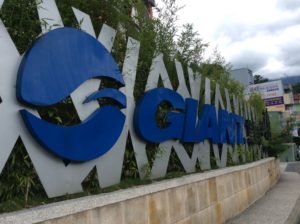
GIANTから自転車をお借りしました。
天気を訊いたら雨は降らないとのこと。
安心してスタートを切りました!
CNN傘下の旅行情報サイトにて世界で最も美しいサイクリングコース ベスト10にも選ばれており、
晴れていればとても美しい湖です。
自転車に乗らなくても、遊覧船などでも気軽に楽しめますよ!
次回は阿里山をご案内いたします。
・北米発着の海上コンテナ輸送でご相談の方はこちら
・全世界へのフラットラック・オープントップコンテナ(オーバーゲージカーゴ)の輸送でご相談の方はこちら
投稿者
ジャパントラスト株式会社
小原 大樹
インサイドセールス 兼 経営企画室 IT担当 宮城県仙台市出身 趣味は海外旅行、登山、ダイビング、中国語。 2019年に東マレーシアのキナバル山4095mを登頂、次はキリマンジャロ登頂を目指します。
2020年02月01日
WAYBILL(収入印紙)について
拝啓 貴社ますますご盛栄のこと、お喜び申し上げます。また、平素より格別のご愛顧を賜り、厚く御礼申し上げます。
さて、WEYBILL発行について添付のとおりご案内いたします。
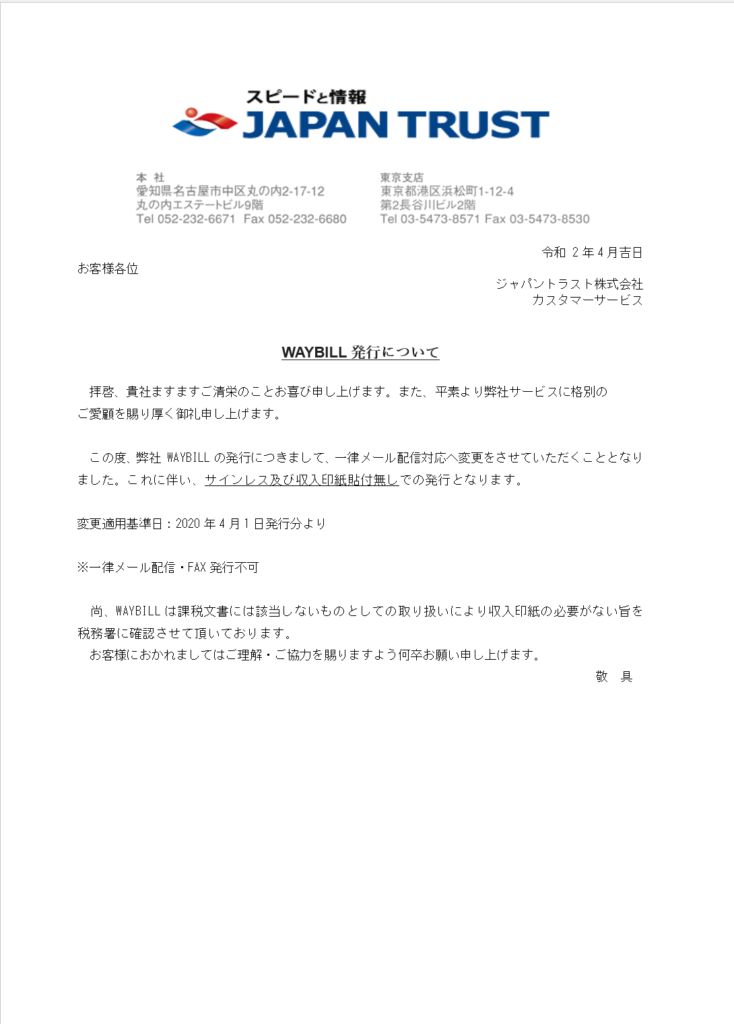
ご不明な点等ございましたら、各営業担当者までお知らせ下さい。
お客様におかれましてはご理解・ご協力を賜りますよう何卒お願い申し上げます
投稿者
ジャパントラスト株式会社
- ブログ (452)
- コラム/最適物流の科学 (52)
- ニュース (155)
- 2025年6月 (3)
- 2025年5月 (4)
- 2025年4月 (4)
- 2025年3月 (4)
- 2025年2月 (4)
- 2025年1月 (4)
- 2024年12月 (3)
- 2024年11月 (2)
- 2024年10月 (2)
- 2024年9月 (4)
- 2024年8月 (5)
- 2024年7月 (5)
- 2024年6月 (5)
- 2024年5月 (4)
- 2024年4月 (5)
- 2024年3月 (6)
- 2024年2月 (3)
- 2024年1月 (3)
- 2023年12月 (5)
- 2023年11月 (4)
- 2023年10月 (3)
- 2023年9月 (4)
- 2023年8月 (4)
- 2023年7月 (3)
- 2023年6月 (3)
- 2023年5月 (4)
- 2023年4月 (4)
- 2023年3月 (4)
- 2023年2月 (4)
- 2023年1月 (3)
- 2022年12月 (3)
- 2022年11月 (3)
- 2022年10月 (4)
- 2022年9月 (3)
- 2022年8月 (4)
- 2022年7月 (9)
- 2022年6月 (6)
- 2022年5月 (8)
- 2022年4月 (6)
- 2022年3月 (7)
- 2022年2月 (5)
- 2022年1月 (6)
- 2021年12月 (3)
- 2021年11月 (8)
- 2021年10月 (5)
- 2021年9月 (4)
- 2021年8月 (7)
- 2021年7月 (4)
- 2021年6月 (4)
- 2021年5月 (6)
- 2021年4月 (3)
- 2021年3月 (5)
- 2021年2月 (2)
- 2021年1月 (6)
- 2020年12月 (4)
- 2020年11月 (3)
- 2020年10月 (3)
- 2020年9月 (6)
- 2020年8月 (1)
- 2020年7月 (2)
- 2020年6月 (3)
- 2020年5月 (4)
- 2020年4月 (6)
- 2020年3月 (5)
- 2020年2月 (6)
- 2020年1月 (5)
- 2019年12月 (5)
- 2019年11月 (4)
- 2019年10月 (7)
- 2019年9月 (6)
- 2019年8月 (3)
- 2019年7月 (3)
- 2019年6月 (2)
- 2019年5月 (6)
- 2019年4月 (7)
- 2019年3月 (5)
- 2019年2月 (7)
- 2019年1月 (3)
- 2018年12月 (2)
- 2018年11月 (2)
- 2018年10月 (1)
- 2018年9月 (1)
- 2018年8月 (3)
- 2018年7月 (2)
- 2018年6月 (4)
- 2018年5月 (1)
- 2018年4月 (3)
- 2018年3月 (3)
- 2018年2月 (6)
- 2018年1月 (1)
- 2017年12月 (1)
- 2017年11月 (6)
- 2017年10月 (2)
- 2017年9月 (4)
- 2017年8月 (4)
- 2017年7月 (1)
- 2017年6月 (5)
- 2017年5月 (3)
- 2017年4月 (5)
- 2017年3月 (1)
- 2017年2月 (3)
- 2017年1月 (7)
- 2016年12月 (4)
- 2016年11月 (4)
- 2016年10月 (7)
- 2016年9月 (7)
- 2016年8月 (7)
- 2016年7月 (7)
- 2016年6月 (6)
- 2016年5月 (6)
- 2016年4月 (2)
- 2016年3月 (6)
- 2016年2月 (11)
- 2016年1月 (6)
- 2015年12月 (5)
- 2015年11月 (5)
- 2015年10月 (5)
- 2015年9月 (8)
- 2015年8月 (8)
- 2015年7月 (8)
- 2015年6月 (9)
- 2015年5月 (3)
- 2015年4月 (3)
- 2015年3月 (8)
- 2015年2月 (6)
- 2015年1月 (2)
- 2014年12月 (5)
- 2014年11月 (5)
- 2014年10月 (6)
- 2014年9月 (5)
- 2014年8月 (7)
- 2014年7月 (4)
- 2014年6月 (7)
- 2014年5月 (3)
- 2014年4月 (6)
- 2014年3月 (3)
- 2014年2月 (6)
- 2014年1月 (3)
- 2013年12月 (2)
- 2013年11月 (6)
- 2013年10月 (3)
- 2013年9月 (5)
- 2013年8月 (5)
- 2013年7月 (4)
- 2013年6月 (2)


